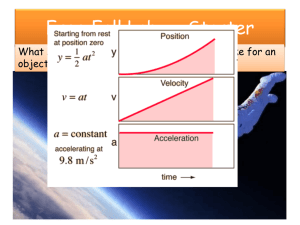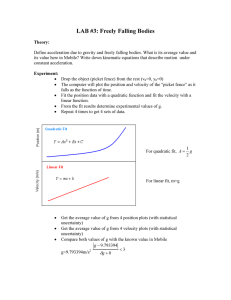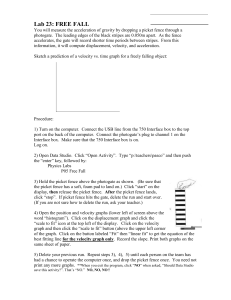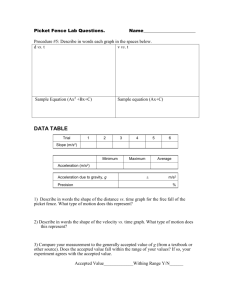5 Picket Fence Free Fall Experiment
advertisement
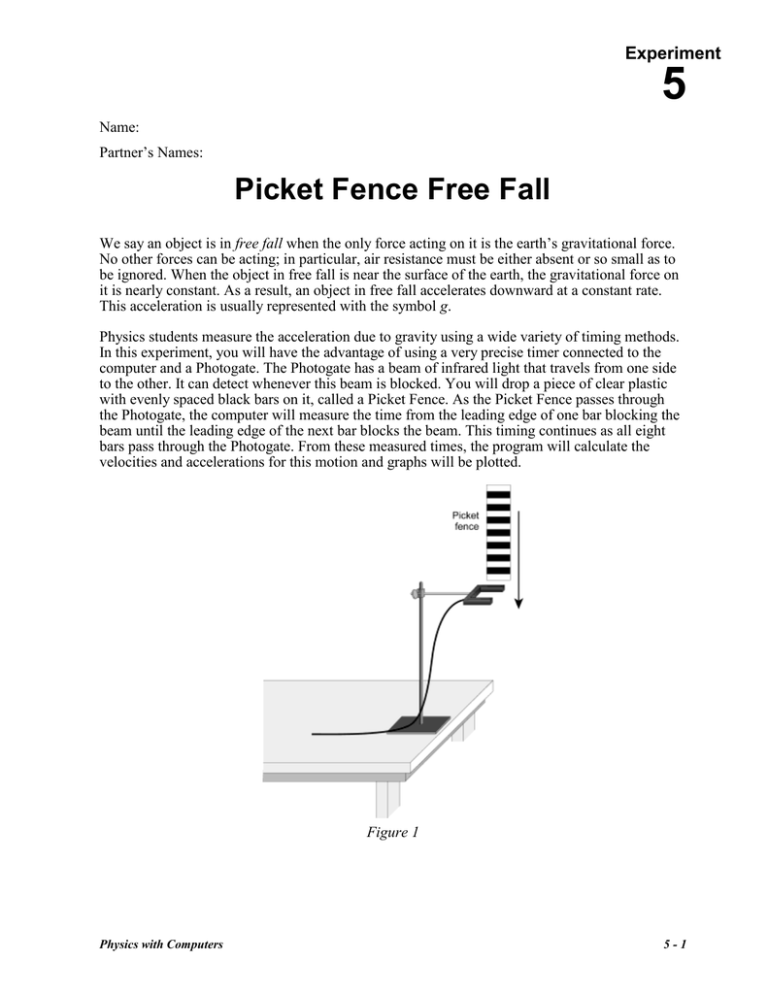
Experiment 5 Name: Partner’s Names: Picket Fence Free Fall We say an object is in free fall when the only force acting on it is the earth’s gravitational force. No other forces can be acting; in particular, air resistance must be either absent or so small as to be ignored. When the object in free fall is near the surface of the earth, the gravitational force on it is nearly constant. As a result, an object in free fall accelerates downward at a constant rate. This acceleration is usually represented with the symbol g. Physics students measure the acceleration due to gravity using a wide variety of timing methods. In this experiment, you will have the advantage of using a very precise timer connected to the computer and a Photogate. The Photogate has a beam of infrared light that travels from one side to the other. It can detect whenever this beam is blocked. You will drop a piece of clear plastic with evenly spaced black bars on it, called a Picket Fence. As the Picket Fence passes through the Photogate, the computer will measure the time from the leading edge of one bar blocking the beam until the leading edge of the next bar blocks the beam. This timing continues as all eight bars pass through the Photogate. From these measured times, the program will calculate the velocities and accelerations for this motion and graphs will be plotted. Figure 1 Physics with Computers 5-1 Experiment 5 OBJECTIVE Measure the acceleration of a freely falling body (g) to better than 0.5% precision using a Picket Fence and a Photogate. MATERIALS Windows PC LabPro Logger Pro Vernier Photogate Picket Fence clamp or ring stand to secure Photogate PRELIMINARY QUESTIONS 1. Inspect your Picket Fence. You will be dropping it through a Photogate to measure g. The distance, measured from one edge of a black band to the same edge of the next band, is 5.0 cm. What additional information will you need to determine the average speed of the Picket Fence as it moves through the Photogate? 2. If an object is moving with constant acceleration, what is the shape of its velocity vs. time graph? velocity time 3. Does the initial velocity of an object have anything to do with its acceleration? For example, compared to dropping an object, if you throw it downward would the acceleration be different after you released it? Explain. 5-2 Physics with Computers Picket Fence Free Fall PROCEDURE 1. Fasten the Photogate rigidly to a ring stand so the arms extend horizontally, as shown in Figure 1. The entire length of the Picket Fence must be able to fall freely through the Photogate. To avoid damaging the Picket Fence, make sure it has a soft surface (such as a carpet) to land on. 2. Connect the Photogate to the DIG/SONIC 1 input of the LabPro. 3. Open the file in the Experiment 5 folder of Physics with Computers. Two graphs will appear on the screen. The top graph displays distance vs. time, and the lower graph velocity vs. time. 4. Observe the reading in the status bar of Logger Pro at the bottom of the screen. Block the Photogate with your hand; note that the Photogate is shown as blocked. Remove your hand and the display should change to unblocked. 5. Click to prepare the Photogate. Hold the top of the Picket Fence and drop it through the Photogate, releasing it from your grasp completely before it enters the Photogate. Be careful when releasing the Picket Fence. It must not touch the sides of the Photogate as it falls and it needs to remain vertical. Click to end data collection. 6. Examine your graphs. The slope of a velocity vs. time graph is a measure of acceleration. If the velocity graph is approximately a straight line of constant slope, the acceleration is constant. If the acceleration of your Picket Fence appears constant, fit a straight line to your data. To do this, click on the velocity graph once to select it, then click to fit the line y = mx + b to the data. Record the slope in the data table. Click on the distance graph to select it, then click curve fit (quadratic). Print both of the graphs containing their statistical information. 7. To establish the reliability of your slope measurement, repeat Steps 5 and 6 five more times. Do not use drops in which the Picket Fence hits or misses the Photogate. Record the slope values in the data table. Do NOT print runs 2 – 6. DATA TABLE Trial 1 2 3 4 5 6 2 Slope (m/s ) Minimum Maximum Average 2 Acceleration (m/s ) Acceleration due to gravity, g Precision m/s 2 % ANALYSIS 1. From your six trials, determine the minimum, maximum, and average values for the acceleration of the Picket Fence. Record them in the data table. Physics with Computers 5-3 Experiment 5 2. Describe in words and sketch the shape of the distance vs. time graph for the free fall. distance time 3. Describe in words and sketch the shape of the velocity vs. time graph. How is the velocity graph derived from the shape of the distance vs. time graph? velocity time 4. The average acceleration you determined represents a single best value, derived from all your measurements. The minimum and maximum values give an indication of how much the measurements can vary from trial to trial; that is, they indicate the precision of your measurement. One way of stating the precision is to take half of the difference between the minimum and maximum values and use the result as the uncertainty of the measurement. Express your final experimental result as the average value, the uncertainty. Round the uncertainty to just one digit and round the average value to the same decimal place. For example, if your minimum, average2 and maximum values are 9.12, 9.93, and 10.84 m/s2, express your result as g = 9.9 ± 0.9 m/s . Record your values in the data table 5. Express the uncertainty as a percentage of the acceleration. This is the precision of your experiment. Enter the value in your data table. Using the example numbers from the last step, the precision would be 0 .9 100% 9 0 0 9 .9 5-4 Physics with Computers Picket Fence Free Fall 6. Compare your measurement to the theoretical value of g (9.8 m/s2) by doing a percent error calculation. Percent Error = |Theoretical – Average g| x 100 Theoretical 7. Inspect your velocity graph. How would the associated acceleration vs. time graph look? Sketch your prediction on paper. Now change the upper graph to acceleration vs. time. Do this by clicking on the y-axis label. Select Acceleration, then deselect Distance and click . Comment on any differences. You need to rescale the graph so that the acceleration axis (the y-axis) begins at zero and ends at 12. To do this, double-click on the axis and reset the minimum to zero and the maximum to 12. Accel. time 8. Using the acceleration vs. time graph on the screen, click on acceleration. Record the mean value in the space below. to determine the average 9. Do a percent difference calculation between mean acceleration value in step 8 and for the average slope of the velocity vs. time graph from your data table? Percent Difference = |Difference of the two values| x 100 Average of the two values EXTENSIONS 1. Using the distance vs. time graph with the quadratic statistical information and the formula x = vot + 1/2at2, discuss how you would determine g. Physics with Computers 5-5

